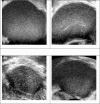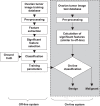GyneScan: an improved online paradigm for screening of ovarian cancer via tissue characterization
- PMID: 24325128
- PMCID: PMC4527478
- DOI: 10.7785/tcrtexpress.2013.600273
GyneScan: an improved online paradigm for screening of ovarian cancer via tissue characterization
Abstract
Ovarian cancer is the fifth highest cause of cancer in women and the leading cause of death from gynecological cancers. Accurate diagnosis of ovarian cancer from acquired images is dependent on the expertise and experience of ultrasonographers or physicians, and is therefore, associated with inter observer variabilities. Computer Aided Diagnostic (CAD) techniques use a number of different data mining techniques to automatically predict the presence or absence of cancer, and therefore, are more reliable and accurate. A review of published literature in the field of CAD based ovarian cancer detection indicates that many studies use ultrasound images as the base for analysis. The key objective of this work is to propose an effective adjunct CAD technique called GyneScan for ovarian tumor detection in ultrasound images. In our proposed data mining framework, we extract several texture features based on first order statistics, Gray Level Co-occurrence Matrix and run length matrix. The significant features selected using t-test are then used to train and test several supervised learning based classifiers such as Probabilistic Neural Networks (PNN), Support Vector Machine (SVM), Decision Tree (DT), k-Nearest Neighbor (KNN), and Naive Bayes (NB). We evaluated the developed framework using 1300 benign and 1300 malignant images. Using 11 significant features in KNN/PNN classifiers, we were able to achieve 100% classification accuracy, sensitivity, specificity, and positive predictive value in detecting ovarian tumor. Even though more validation using larger databases would better establish the robustness of our technique, the preliminary results are promising. This technique could be used as a reliable adjunct method to existing imaging modalities to provide a more confident second opinion on the presence/absence of ovarian tumor.
Conflict of interest statement
Figures
Similar articles
-
Evolutionary algorithm-based classifier parameter tuning for automatic ovarian cancer tissue characterization and classification.Ultraschall Med. 2014 Jun;35(3):237-45. doi: 10.1055/s-0032-1330336. Epub 2012 Dec 20. Ultraschall Med. 2014. PMID: 23258769
-
Non-invasive automated 3D thyroid lesion classification in ultrasound: a class of ThyroScan™ systems.Ultrasonics. 2012 Apr;52(4):508-20. doi: 10.1016/j.ultras.2011.11.003. Epub 2011 Nov 25. Ultrasonics. 2012. PMID: 22154208
-
Ovarian tumor characterization and classification using ultrasound-a new online paradigm.J Digit Imaging. 2013 Jun;26(3):544-53. doi: 10.1007/s10278-012-9553-8. J Digit Imaging. 2013. PMID: 23160866 Free PMC article.
-
Ovarian tissue characterization in ultrasound: a review.Technol Cancer Res Treat. 2015 Jun;14(3):251-61. doi: 10.1177/1533034614547445. Epub 2014 Sep 16. Technol Cancer Res Treat. 2015. PMID: 25230716 Review.
-
Reviewing ensemble classification methods in breast cancer.Comput Methods Programs Biomed. 2019 Aug;177:89-112. doi: 10.1016/j.cmpb.2019.05.019. Epub 2019 May 20. Comput Methods Programs Biomed. 2019. PMID: 31319964 Review.
Cited by
-
GeneAI 3.0: powerful, novel, generalized hybrid and ensemble deep learning frameworks for miRNA species classification of stationary patterns from nucleotides.Sci Rep. 2024 Mar 26;14(1):7154. doi: 10.1038/s41598-024-56786-9. Sci Rep. 2024. PMID: 38531923 Free PMC article.
-
Multimodality carotid plaque tissue characterization and classification in the artificial intelligence paradigm: a narrative review for stroke application.Ann Transl Med. 2021 Jul;9(14):1206. doi: 10.21037/atm-20-7676. Ann Transl Med. 2021. PMID: 34430647 Free PMC article. Review.
-
A narrative review on characterization of acute respiratory distress syndrome in COVID-19-infected lungs using artificial intelligence.Comput Biol Med. 2021 Mar;130:104210. doi: 10.1016/j.compbiomed.2021.104210. Epub 2021 Jan 18. Comput Biol Med. 2021. PMID: 33550068 Free PMC article. Review.
-
Analysis of computer-aided diagnostics in the preoperative diagnosis of ovarian cancer: a systematic review.Insights Imaging. 2023 Feb 15;14(1):34. doi: 10.1186/s13244-022-01345-x. Insights Imaging. 2023. PMID: 36790570 Free PMC article. Review.
-
COVID-19 pathways for brain and heart injury in comorbidity patients: A role of medical imaging and artificial intelligence-based COVID severity classification: A review.Comput Biol Med. 2020 Sep;124:103960. doi: 10.1016/j.compbiomed.2020.103960. Epub 2020 Aug 14. Comput Biol Med. 2020. PMID: 32919186 Free PMC article. Review.
References
-
- Riihimaki M, Hemminki A, Sundquist K. & Hemminki K. Time trends in survival from cancer of unknown primary: Small steps forward. Eur J Cancer 49, 2403–2410, (2013). DOI: 10.1016/j.ejca.2013.02.022. - PubMed
-
- Attard G. & Kaye SB. Identifying prognostic signatures in the blood of ovarian cancer patients. Gynecol Oncol 128, 1–2, (2013). DOI: 10.1016/j.ygyno.2012.11.011. - PubMed
-
- Morris RT. & Monk BJ. Ovarian cancer: Relevant therapy, not timing, is paramount. The Lancet 376, 1120–1122, (2010). DOI: 10.1016/S0140-6736(10)61515-2. - PubMed
MeSH terms
LinkOut - more resources
Full Text Sources
Other Literature Sources
Miscellaneous



